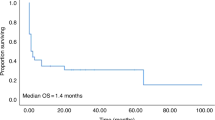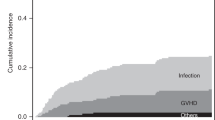Abstract
Serious morbidity and mortality can occur after hematopoietic SCT (HSCT). Critical care outreach (CCO) can provide timely access to intensive care for hospitalized patients in need of urgent stabilization but has not been examined in HSCT. Rapid Assessment of Critical Events (RACE) team was introduced at our centre January 1, 2005. A retrospective cohort study was performed. Patients undergoing HSCT between January 1, 2000 and December 31, 2004 (n=520) formed the ‘before’ cohort and patients transplanted between January 1, 2005 and December 31, 2007 (n=294) formed the ‘after’ cohort. Non-relapse mortality at day 100 after transplant was not different in the two cohorts (26 (8.8%) post-RACE vs 53 (10.2%) pre-RACE, P=0.62). The number of failed organs at time of transfer to intensive care unit (ICU) was reduced in the post-RACE cohort (1.9±0.8 vs 2.3±1.0, P=0.04) and the incidence of cardiovascular failure was lower (23.8 vs 43.8%, P=0.04). Other secondary outcomes were not different, including the frequency of ICU admission. RACE may contribute to earlier stabilization during critical illness in patients undergoing HSCT but does not reduce non-relapse mortality. CCO should be studied prospectively in patients undergoing HSCT to better evaluate its role.
This is a preview of subscription content, access via your institution
Access options
Subscribe to this journal
Receive 12 print issues and online access
$259.00 per year
only $21.58 per issue
Buy this article
- Purchase on Springer Link
- Instant access to full article PDF
Prices may be subject to local taxes which are calculated during checkout
Similar content being viewed by others
References
Afessa B, Peters SG . Major complications following hematopoietic stem cell transplantation. Semin Respir Crit Care Med 2006; 27: 297–309.
Orasch C, Weisser M, Mertz D, Conen A, Heim D, Christen S et al. Comparison of infectious complications during induction/consolidation chemotherapy versus allogeneic hematopoietic stem cell transplantation. Bone Marrow Transplant 2010; 45: 521–526.
Soubani AO . Critical care considerations of hematopoietic stem cell transplantation. Crit Care Med 2006; 34 (Suppl 9): S251–S267.
Kew AK, Couban S, Patrick W, Thompson K, White D . Outcome of hematopoietic stem cell transplant recipients admitted to the intensive care unit. Biol Blood Marrow Transplant 2006; 12: 301–305.
Soubani AO, Kseibi E, Bander JJ, Klein JL, Khanchandani G, Ahmed HP et al. Outcome and prognostic factors of hematopoietic stem cell transplantation recipients admitted to a medical ICU. Chest 2004; 126: 1604–1611.
Trinkaus MA, Lapinsky SE, Crump M, Keating A, Reece DE, Chen C et al. Predictors of mortality in patients undergoing autologous hematopoietic cell transplantation admitted to the intensive care unit. Bone Marrow Transplant 2009; 43: 411–415.
Naeem N, Reed MD, Creger RJ, Youngner SJ, Lazarus HM . Transfer of the hematopoietic stem cell transplant patient to the intensive care unit: does it really matter? Bone Marrow Transplant 2006; 37: 119–133.
Price KJ, Thall PF, Kish SK, Shannon VR, Andersson BS . Prognostic indicators for blood and marrow transplant patients admitted to an intensive care unit. Am J Respir Crit Care Med 1998; 158: 876–884.
Ninin E, Milpied N, Moreau P, André-Richet B, Morineau N, Mahé B et al. Longitudinal study of bacterial, viral and fungal infections in adult recipients of bone marrow transplants. Clin Inf Dis 2001; 33: 41–47.
Pène F, Aubron C, Azoulay E, Blot F, Thiéry G, Raynard B et al. Outcome of critically ill allogeneic hematopoietic stem-cell transplantation recipients: a reappraisal of indications for organ failure supports. J Clin Oncol 2006; 24: 643–649.
Franklin C, Mathew J . Developing strategies to prevent in-hospital cardiac arrest: analyzing responses of physicians and nurses in the hours before the event. Crit Care Med 1994; 22: 244–247.
Welch J . Using assessment to identify and prevent critical illness. Nurs Times Plus 2000; 96: 3–4.
McQuillan P, Pilkington S, Allan A, Taylor B, Short A, Morgan G et al. Confidential enquiry into quality of care before admission to critical care. Br Med J 1998; 316: 1853–1858.
Lee A, Bishop G, Hillman KM, Daffum K . The medical emergency team. Anaesth Intensive Care 1995; 23: 183–186.
Hillman K, Chen J, Cretikos M, Bellomo R, Brown D, Doig G et al. Introduction of the medical emergency team (MET) system: a cluster-randomised controlled trial. Lancet 2005; 365: 2091–2097.
Jones D, Bellomo R, Bates S, Warrillow S, Goldsmith D, Hart G et al. Long term effect of a medical emergency team on cardiac arrests in a teaching hospital. Crit Care 2005; 9: R808–R815.
McGaughey J, Alderdice F, Fowler R, Kapila A, Mayhew A, Moutray M . Outreach and Early Warning Systems (EWS) for the prevention of intensive care admission and death of critically ill adult patients on general hospital wards. Cochrane Database Syst Rev 2007; 18: CD005529.
Baxter AD, Cardinal P, Hooper J, Patel R . Medical emergency teams at The Ottawa Hospital: the first two years. Can J Anaesth 2008; 55: 223–231.
Iyengar A, Baxter A, Forster AJ . Using medical emergency teams to detect preventable adverse events. Crit Care 2009; 13: R126.
Dacey MJ, Mirza ER, Wilcox V, Doherty M, Mello J, Boyer J et al. The effect of a rapid response team on major clinical outcome measures in a community hospital. Crit Care Med 2007; 35: 2076–2082.
Ball C, Kirkby M, Williams S . Effect of the critical care outreach team on patient survival to discharge from hospital and readmission to critical care: non-randomized population based study. BMJ 2003; 327: 1014–1018.
Priestley G, Watson W, Rashidian A, Mozley C, Russell D, Wilson J et al. Introducing critical care outreach: a ward-randomized trial of phased introduction in a general hospital. Intensive Care Med 2004; 30: 1398–1404.
Bellomo R, Goldsmith D, Uchino S, Buckmaster J, Hart GK, Opdam H et al. A prospective before and after trial of a medical emergency team. Med J Aust 2003; 179: 283–287.
Bellomo R, Goldsmith D, Uchino S, Buckmaster J, Hart GK, Opdam H et al. Prospective controlled trial of effect of medical emergency team on postoperative morbidity and mortality rates. Crit Care Med 2004; 32: 916–921.
Story DA, Shelton AC, Poustie SJ, Colin-Thorne NJ, McNichol PL . The effect of critical care outreach on postoperative serious adverse events. Anaesthesia 2004; 59: 762–766.
DeVita MA, Braithwaite RS, Mahidhara R, Stuart S, Foraida M, Simmons RL . Use of medical emergency team responses to reduce hospital cardiopulmonary arrests. Qual Safety Health Care 2004; 13: 251–254.
Buist MD, Moore GE, Bernard SA, Waxman BP, Anderson TN, Nguyen TV . Effects of a medical emergency team on reduction of incidence of and mortality from unexpected cardiac arrests in hospital: preliminary study. BMJ 2002; 324: 387–390.
Bone RC, Balk RA, Cerra FB, Dellinger RP, Fein RM, Knaus WA et al. Definitions for sepsis and organ failure and guidelines for the use of innovative therapies in sepsis. The ACCP/SCCM consensus conference committee. American college of chest physicians/society of critical care medicine. Chest 1992; 101: 1644–1655.
Bernard GR, Vincent JL, Laterre PF, LaRosa SP, Dhainaut JF, Lopez-Rodriguez A et al. Efficacy and safety of recombinant human activated protein C for severe sepsis. N Engl J Med 2001; 344: 699–709.
Bernard GR, Artigas A, Brigham KL, Carlet J, Falke K, Hudson L et al. The American-European consensus conference on ARDS. Am J Respir Crit Care Med 1994; 149: 818–824.
Knaus WA, Draper EA, Wagner DP, Zimmerman JE . APACHE II: a severity of disease classification system. Crit Care Med 1985; 13: 818–829.
Afessa B, Tefferi A, Dunn WF, Litzow MR, Peters SG . Intensive care unit support and Acute Physiology and Chronic Health Evaluation III performed in hematopoietic stem cell transplant recipients. Crit Care Med 2003; 31: 1715–1721.
Kim SW, Kami M, Urahama N, Yamamoto R, Hori A, Imataki O et al. Feasibility of acute physiology and chronic health evaluation (APACHE) II and III score-based screening in patients receiving allogeneic hematopoietic stem-cell transplantation. Transplantation 2003; 75: 566–570.
Rivers E, Nguyen B, Havstad S, Ressler J, Muzzin A, Knoblich B et al. Early goal-directed therapy in the treatment of severe sepsis and septic shock. N Engl J Med 2001; 345: 1368–1377.
Acknowledgements
We thank Dr Lothar Huebsch and Sheryl McDiarmid for assistance with the database. This study was supported by funds from the Ministry of Health and Long-term Care in Ontario and The Ottawa Hospital (RACE team); The Ottawa Hospital Foundation Bone Marrow Transplant Research Fund for a summer studentship (AC) and to support the clinical BMT database at The Ottawa Hospital Blood and Marrow Transplant Program. DA is an adjunct scientist with Canadian Blood Services, Ottawa (Canada) and holds a New Investigator Award from the Canadian Institutes for Health Research and a Research Award from the Department of Medicine, University of Ottawa.
Author information
Authors and Affiliations
Corresponding author
Ethics declarations
Competing interests
The authors declare no conflict of interest.
Rights and permissions
About this article
Cite this article
Hayani, O., Al-Beihany, A., Zarychanski, R. et al. Impact of critical care outreach on hematopoietic stem cell transplant recipients: a cohort study. Bone Marrow Transplant 46, 1138–1144 (2011). https://doi.org/10.1038/bmt.2010.248
Received:
Revised:
Accepted:
Published:
Issue Date:
DOI: https://doi.org/10.1038/bmt.2010.248
Keywords
This article is cited by
-
High-flow nasal cannula oxygen in patients with haematological malignancy: a retrospective observational study
Annals of Hematology (2022)
-
Lebensrettende Systeme
Notfall + Rettungsmedizin (2021)
-
Outcomes of hospitalized hematologic oncology patients receiving rapid response system activation for acute deterioration
Critical Care (2019)
-
Critically ill allogenic HSCT patients in the intensive care unit: a systematic review and meta-analysis of prognostic factors of mortality
Bone Marrow Transplantation (2018)
-
Long-term outcomes in patients treated in the intensive care unit after hematopoietic stem cell transplantation
International Journal of Hematology (2018)



